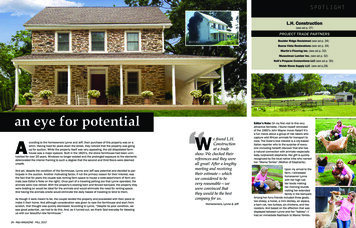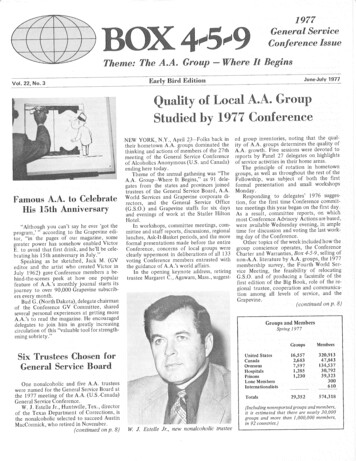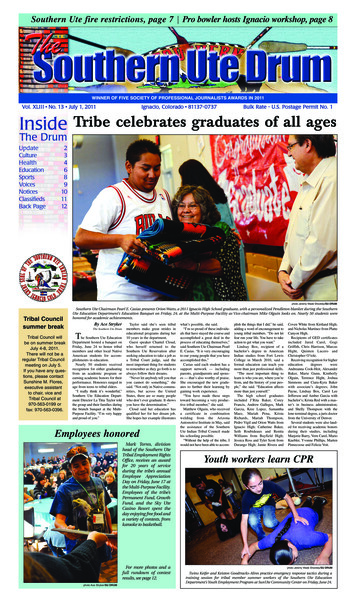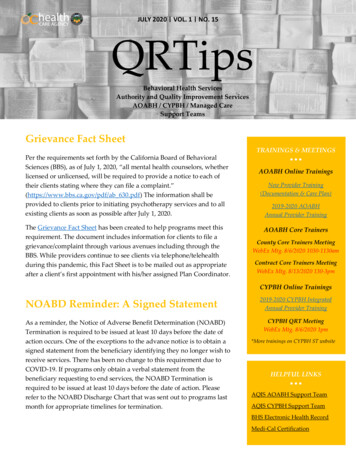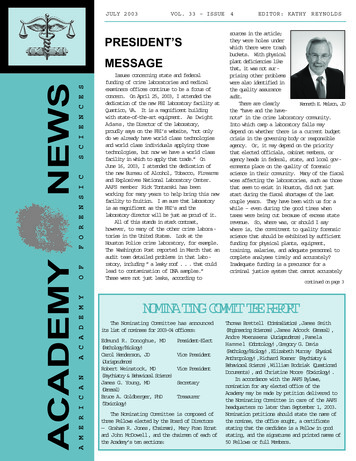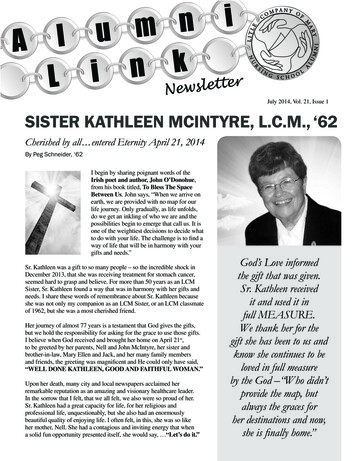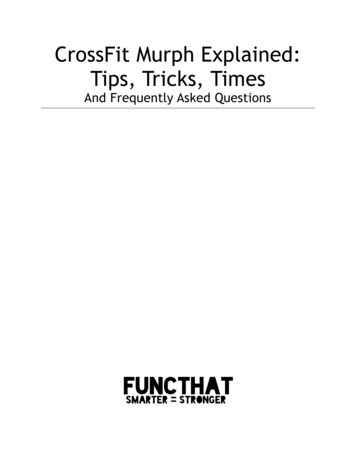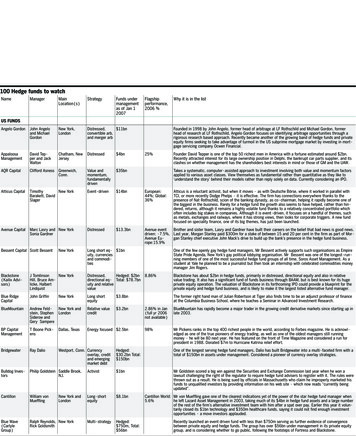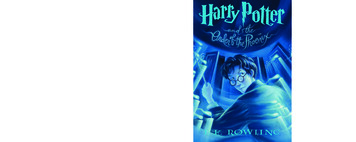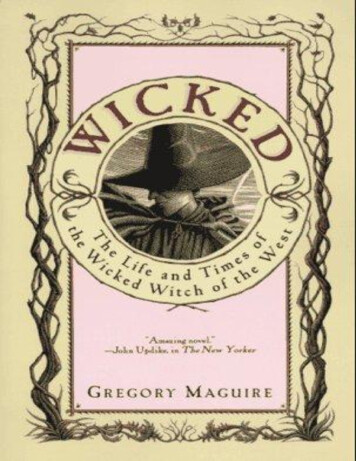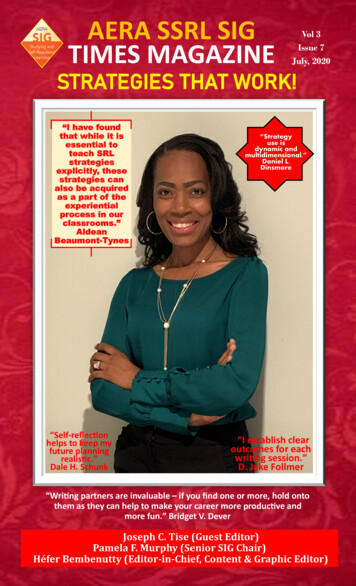
Transcription
AERA SSRL SIGTIMES MAGAZINEVol 3Issue 7July, 2020STRATEGIES THAT WORK!“I have foundthat while it isessential toteach SRLstrategiesexplicitly, thesestrategies canalso be acquiredas a part of theexperientialprocess in ctionhelps to keep myfuture planningrealistic.”Dale H. Schunk“Strategyuse isdynamic andmultidimensional.”Daniel L.Dinsmore“I establish clearoutcomes for eachwriting session.”D. Jake Follmer“Writing partners are invaluable – if you find one or more, hold ontothem as they can help to make your career more productive andmore fun.” Bridget V. DeverJoseph C. Tise (Guest Editor)Pamela F. Murphy (Senior SIG Chair)Héfer Bembenutty (Editor-in-Chief, Content & Graphic Editor)
AERA SSRL SIGTIMES MAGAZINEVol 3, Issue 7July, 2020EDITORIAL: AN ANTHOLOGY OF STRATEGICTHOUGHT AND ACTIONOne of the overarchinggoals of education is“the transfer ofresponsibility forlearning to the individual”(Weinstein, 1994, p. 267). Thiseducational goal unites theStudying and Self-RegulatedLearning (SSRL) Special InterestGroup (SIG) of the AmericanEducational Research Association(AERA) and the readership ofthe Times Magazine.As researchers andeducators, we may focus on oneor two of the numerous paths topursue that goal—be it through afocus on metacognition,emotional or behavioralregulation, or strategy use. Thisissue of the SSRL SIG TimesMagazine is dedicated to thelatter of these approaches:strategies we use andrecommend to others.Each contributor to thisissue of the Times Magazinethoughtfully described one ormultiple strategies they use toaid their self-regulation. Theauthors contextualized theirstrategy use within differenttasks, job duties, and evendifferent self-regulatorydomains.All authors shared acommon goal for this issue. Thatgoal was to compile a set ofreflective essays about how eachauthor harnesses the power ofstrategic thought and action. Ihope this issue can serve as asmall anthology for thoseseeking to improve their strategyuse and productivity.The contributors to thisissue have diverse experiencesand perspectives—from tenuredscholars to an observantundergraduate student. Thetopics and strategies discussedare just as various. To illustrate,Dale Schunk writes about thepower of self-reflection tomaintain productivity, enhancemotivation, and inform futureplanning.D. Jake Follmer takes abroader approach and describesJoseph C. Tise (Penn State)five strategies he uses to bolsterwriting productivity, includingsetting goals, outlining, blockingtime, following the 2-2-2 rule,and staying learner-centered.Those five strategies appear tobe “ready to use” for anyoneinterested.Ying Wang, a dissertationstage graduate student,identifies ways to establishstandards for her writing as anon-native English speaker.Wang also describes a strategyshe uses to support a large, multi-institutional NSF-funded project.Laith Jumah discusses thechallenges of being aninternational instructor inAmerican universities. He alsopartner.Adar Ben-Eliyahudescribes how she uses acollection of strategies toregulate emotion, behavior, andcognition. Ben-Eliyahu notes thattwo overarching elements (beingflexible and letting go) influencethese strategies.Daniel Moos writes aboutstrategies he uses to monitor histeaching effectiveness. One suchstrategy he uses is to harnesscolleague and studentobservations and feedback. Inlike manner, Taylor Young, anundergraduate student at PennState, re-affirms some strategiesMoos discusses. She provideskeen observations aboutstrategies her instructors haveused that improved her learning.Aldean Beaumont-Tynesdescribes how goal setting andself-monitoring maintain utilityeven in the unconventionaleducational landscape we findourselves in due to the COVID-19pandemic. Nathalis Wambathoughtfully challenges thetraditional conceptualization oflearning and provides strategiesinstructors can use in theJoseph C. Tiseclassroom to empower learnersto do the same.Finally, Dan DinsmoreJoseph C. Tise is a Ph.D.provides “meta-advice” to advicecandidate in the EducationalPsychology program at Pennrecipients. Specifically, that weState. His research interestsshould always reflect on thecenter around strategiccontextual differences we mightprocessing and metacognition.face between the advice-giverHis dissertation will harnessand ourselves—apt advice givendaily-life methodology toby one may not always apply orexamine post-secondarybe most effective to our contextsstudents’ SRL strategy useand situations.within an authentic learningStrategic scholarship canenvironment.take many forms and pertain towrites about how respect andmany domains. Regardless of thelearning strategies can beparticular domain we target forharnessed to support studentstrategy use or specific strategysuccess.we use, the reality is that we areBridget Dever writesstrategic. Just as we hope andabout the benefits ofexpect learners to become selfmetacognitively planning herregulated learners, so we toowork by setting self-imposedmust continually self-regulatedeadlines, creating sub-goals,our work. Strategic thought andand blocking time for a project. action will help progressShe also discusses the benefits of research and our careers.co-regulation with a writingReferences are listed on Page 14.The opinions and research claims expressed in Times Magazine are those of the authors and do not necessary reflect the position of the AERA or our SIG SSRL.We do not fact-check every claim. Readers should judge the quality of the opinions and research claims and engage in direct conversation with the authors.Page 2
AERA SSRL SIGTIMES MAGAZINEVol 3, Issue 7July, 2020SETTING GOALS AND SELF-MONITORINGAldean Beaumont-TynesANewark Board of Education, Queens College, & Seton Hall Universitys I reflect on the“At the end of this semester, ISpring 2020will feel more comfortablesemester, I realizetalking in front of others” orthat as much as I“At the end of this semester, I“I have foundvalue consistency andwill be better at timethat this strategy,continuity, such instancesmanagement”).at its core, exemplifieswere few and far between thisWe revisit theseself-regulatedsemester. We were allstatements just after thelearningsignificantly impacted by the midterm exam so thatpractices.”COVID-19 pandemic, and the students can track progressAldeanthrust into online classestowards their goals. IfBeaumont-Tyneseviscerated much hope ofprogress is not being mademaintaining consistency in our towards their goals, they areteaching practices.encouraged to identifyAmid an upheaval ofbarriers to achievement.what I have come to rely on asto not only set goals, but tomy “hallmark teachingself-reflect, and ultimatelystrategies,” one single strategymonitor their progress.remained true to form. ItI have found that thisstood the test of multiple restrategy, at its core,calibrations and vast shifts inexemplifies self-regulatedthe way I deliveredlearning (SRL) practices. Itinstruction. The strategy could“emphasizes autonomy andnot be more straightforward.control by the individual whoIt is one that I have used overmonitors, directs, andthe past decade, and it hasregulates actions toward goalsworked to encourage, and atof information acquisition,times awaken, many of theexpanding expertise, and selfcore principles of selfimprovement” (Paris & Paris,regulated learning in my2001, p 89).students.Chen and Bonner (2019)Aldean Beaumont-TynesThe strategy wasposit that “ withoutbegotten out of a needexplicit instruction inAldeanBeaumont-Tynesisaschoolfor a good “first day ofSRL, students do notpsychologist with the Newark Board ofclass/ice-breakingnaturally develop moreEducation. She is an adjunct professor ofactivity.” On the firstEducational Psychology at Queens College, or better SRLCUNY, and teaches Ethics and Communityday of class, I askstrategy” (p. 2). I s to providefound that while it isthree responses to theessential to teach SRLfollowing statement: “At the Finally, at the end of thestrategies explicitly, theseend of this semester, I will. ” semester, in a brief reflection, strategies can also be acquiredOne can only imagine thestudents write about theiras a part of the experientialrange of responses I havethree goals. This time,process in our classrooms.received over the years.however, instead of “at theAs Paris & Paris (2001)Most students will give end of the semester, I will ” aptly note, “ teachers candomain-specific responsesthey write “at the end of the provide information andthat relate to the course. For semester, I do/do not; can/opportunities to students ofexample, “At the end of thiscannot; am/am not, etc ”all ages that will help themsemester, I will finallyAt its inception, it was become strategic, motivated,understand the purpose ofnot my intent to help students and independent learners” (p.Educational Psychology.”generate goals. However, I89).Others provide more general soon learned that this strategyReferences are listed on Page 14.responses, often with the goal provided a remarkable, yetof improving themselves (e.g., unassuming, way for studentsThe opinions and research claims expressed in Times Magazine are those of the authors and do not necessary reflect the position of the AERA or our SIG SSRL.We do not fact-check every claim. Readers should judge the quality of the opinions and research claims and engage in direct conversation with the authors.Page 3
AERA SSRL SIGTIMES MAGAZINEVol 3, Issue 7July, 2020SELF-REFLECTION STRATEGYDale H. Schunk (University of North Carolina at Greensboro)Aself-regulatedtimes. The results of selfbeneficial for going forward.learning strategy that reflection can be written downThe second benefit ofI often use andor not. It can be very informal self-reflection is that it keepsrecommend isand last from a few seconds to me motivated. Motivationself-reflection. Self-reflection is much longer. However, theincludes cognitive and affectivepart of many models of selfresults of self-reflection canprocesses that combine toregulation. For instance,have at least three significant affect motivation. I periodicallyZimmerman’s (2002) threebenefits.need to take time to reflect onphase model comprisesFirst, self-reflectionmy goals, values, interests, selfforethought, performance, and keeps me focused on the-efficacy, outcomeself-reflection. During selfcurrent task a while longer. Iexpectations, and the like andreflection—which can occurmake a daily to-do list, and Iassess my emotional wellduring pauses whilebeing. Do I feel satisfiedwe are engaged in aand happy about what Itask or when we havehave done? Or do I feelcompleted the task—frustrated—perhapswe reflect on what webecause I wasted toohave done.much time—andDuring selftherefore need to changereflection, we assessthat? Self-reflectionour goal progress,allows me to maintaindecide if our taskthe right level ofapproach is effective,motivation.self-evaluate ourFinally, selfperformance,reflection helps to keepexperience taskmy future planningrelated emotions (e.g.,realistic. Those 15 itemssatisfaction), andon my to-do list are notmake attributions forrealistic; I have neitherour outcomes. Oncethe time nor the energywe finish reflecting,to accomplish all of themDaleH.Schunkwe can cycle back toin a day. Through selfperformance or elsereflection, I understandreturn to forethoughthow long it takes me toto reassess our goalswrite a section of anand strategies.article, plan anRelative toinstructional thought andorganize my ideas for aSchool of Education at the University of Northperformance, selfcommittee meeting, andCarolina at Greensboro. His research andreflection probablyteaching specialties are learning, motivation, so forth. I can betterand self-regulation.gets less researchgauge my future timeattention and often iscommitments when Ishortchanged in practice. Ialways put more on it than Ireflect on my past.teach a course to first-yearcan do. Thus, my tendency isSelf-reflection worksstudents, and when I ask them when I finish one thing tovery well for me, but it goesabout self-reflection, I getmove on to another quickly.against what I might do if leftmany strange looks. It seemsSelf-reflection forces me toto my own devices. I mustthat when these students take pause before I do so I cancontinually remind myself thata break or finish a task, theyevaluate what I have done,it is essential and overall willsimply return to the task ormake attributions for themake me more productive. Trymove on to the next task. Self- outcomes, and decide what Iit for a week and see what youreflection represents newneed to change. A quick shiftthink!learning.to another task prevents meReferences are listed on Page 14.Self-reflection is flexible. from doing these, but theIt can be done any number of results of my reflections areThe opinions and research claims expressed in Times Magazine are those of the authors and do not necessary reflect the position of the AERA or our SIG SSRL.We do not fact-check every claim. Readers should judge the quality of the opinions and research claims and engage in direct conversation with the authors.Page 4
AERA SSRL SIGTIMES MAGAZINEVol 3, Issue 7July, 2020INTERROGATING SELF-REGULATED LEARNING HEGEMONY THROUGHLEARNING, DE-LEARNING AND RE-LEARNING PEDAGOGYNathalis Wamba (Queens College, CUNY)is informal (i.e., contested, delegitimized, and non-regulated)on the other. Informal learning isoften derided because it isunregulated and rests in thelearner's hands and is fed byincidental learning (Boekaerts &Minnaert, 1999).Nathalis WambaNathalis Wamba is aprofessor in the EducationLeadership program atQueens College, CityUniversity of New York.As a post-colonial scholarand a student and apractitioner ofparticipatory actionresearch, I always raise questionsabout the meaning of the wordslearning and knowledge.Reflecting on my years as anacademic, it has become clear tome that today's higher educationinstitutions a
TIMES MAGAZINE Joseph C. Tise (Guest Editor) Pamela F. Murphy (Senior SIG Chair) Héfer Bembenutty (Editor-in-Chief, Content & Graphic Editor) Vol 3 Issue 7 July, 2020 STRATEGIES THAT WORK! I establish clear outcomes for each writing session. D.Jake Follmer Writing partners are invaluable – if you find one or more, hold onto them as they can help to make your career more

